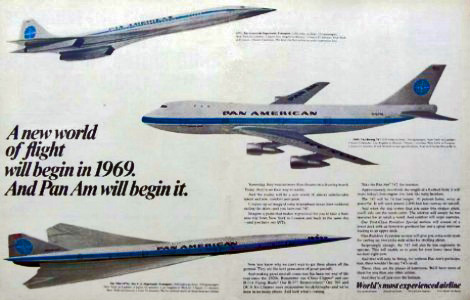A New Dawn, Partially Realized
In 1969, Pan Am was promising both the jumbo jet and the SST. In the end, we only got one of them
In 1969, Pan American was pursuing three ground-breaking aircraft at the same time — the soon-to-be iconic Boeing 747, along with the the Concorde and Boeing Supersonic Transports. In a striking ad, Pan Am highlighted the triad and the dramatic revolution it promised for 1970s air travel. An afternoon business meeting in London? No problem. Hop an SST and be back for dinner. The ad also bragged about how the 747 would be built to the airline’s specifications, which was quite true; Pan Am founder Juan Trippe was ruling Boeing boardrooms as he laid out the airline’s demands even as the ad hit the news stands. (For more about the development of the 747, check out Clive Irving’s excellent book, “Widebody.”)
Of course, the American SST would never proceed beyond a partial mockup (today owned by the Seattle Museum of Flight) and the Concorde would only serve Air France and British Airways, and would operate at a loss for its entire career. The 747, however, would remain in production more than 40 years after it entered service. (The latest version is the 747-8.)
Today’s airline business is a grueling study in cost-cutting and seat-mile computations — the same hard-nosed accounting that doomed Pan Am to bankruptcy in 1991. But a yellowed magazine ad reminds us of a day when the future of air travel innovation seemed limitless, as Americans were walking on the moon, and 2001: A Space Odyssey featured commuters headed to the moon in a Pan Am-flagged shuttle.
/https://tf-cmsv2-smithsonianmag-media.s3.amazonaws.com/accounts/headshot/Sotham_photo.jpg)

/https://tf-cmsv2-smithsonianmag-media.s3.amazonaws.com/accounts/headshot/Sotham_photo.jpg)